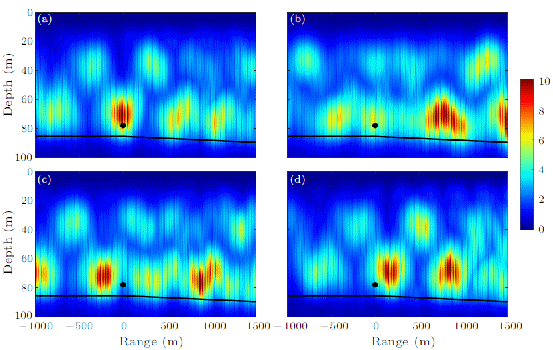Due to the difficulty and high cost of direct measurement for the bottom parameters, geoacoustic inversion as an important kind of indirect methods has received considerable attention in underwater acoustics. A variety of inversion methods have been developed in recent years, most of which are based on active inversion methods where physical properties of the environment affecting acoustic propagation can be retrieved from observations of signals generated by powerful controlled sound sources.
Recently, researchers from Institute of Acoustics, Chinese Academy of Sciences, University of Haifa, and University of Colorado Boulder present a passive geoacoustic inversion method, by using two hydrophones and creating time reversal of ocean noise, to measure the bottom parameters indirectly. This passive acoustic inversion method, which combines noise interferometry (NI) and time reversal mirror (TRM) techniques, employs the ubiquitous ambient noise as a replacement of the designated probing signals. There is no need for any source, so it is a conceptually simple and low-cost method.
For this passive method, a critical issue is Green’s function (GF) retrieval. The GFs between two locations can be estimated by cross-correlating time series of ambient noise recorded at those locations. This process is widely referred to as NI.
The noise cross-correlation function (NCCF) is firstly computed from concurrent measurements of ambient noise at two hydrophones. The NCCF is approximately proportional to the sum of forward and backward GFs between the two receivers.
Next, a TRM is implemented. The retrieved GF is time reversed and back propagated from one receiver, thus producing a focus in the vicinity of the other receiver.
Finally, combined with the Hamilton sediment empirical relationship, the inverse problem is solved by searching over a suitable space of bottom parameter. In order to find the optimal bottom parameters, the displacement of main focus from the virtual sound source, which is one of the receivers recording ambient noise, is minimized.
The presented method is applied to the ambient noise measured by two hydrophones with 8025-m distance in the Shallow Water ’06 experiment. The NCCF is successfully retrieved from a large number of data segments in 5.7 days, and the TRM of ambient noise is performed with variant bottom sound speed.
The displacements of main focus from the virtual sound source are caused by deviations of bottom parameters from their true values (Figure 1).

Figure 1. Displacement of main focus from the virtual sound source versus bottom sound speed (Image by QIN Jixing).
The minimum appears at the optimal sound speed of 1770 m/s, and the optimal density is 2.0 g/cm3 according to the empirical relationship. The optimal bottom parameters can give an excellent focusing quality by the TRM.
In contrast, a mismatch between the actual and assumed bottom parameters shifts and blurs the main focus, while making the spurious additional foci more pronounced (Figure 2).

Figure 2. Time reversal of GF retrieved from noise cross-correlation function in the Shallow Water ’06 experiment (Image by QIN Jixing).
The results of this passive geoacoustic inversion are consistent with those evaluated independently by other means.
Compared with active techniques, this passive inversion method does not contribute to noise pollution in the ocean, and consequently is inherently environmentally friendly. Moreover, it is a low-cost method because only two hydrophones are necessary.
Funding for this research came from the National Natural Science Fund of China under Grant (No. 11434012 and 41561144006).
Reference:
QIN Jixing, KATSNELSON Boris, GODIN Oleg, LI Zhenglin. Geoacoustic Inversion Using Time Reversal of Ocean Noise. Chinese Physics Letters, 2017, 34(9): 094301. DOI:10.1088/0256-307X/34/9/094301.
Contact:
WANG Rongquan
Institute of Acoustics, Chinese Academy of Sciences, 100190 Beijing, China
E-mail: wangrongquan@mail.ioa.ac.cn